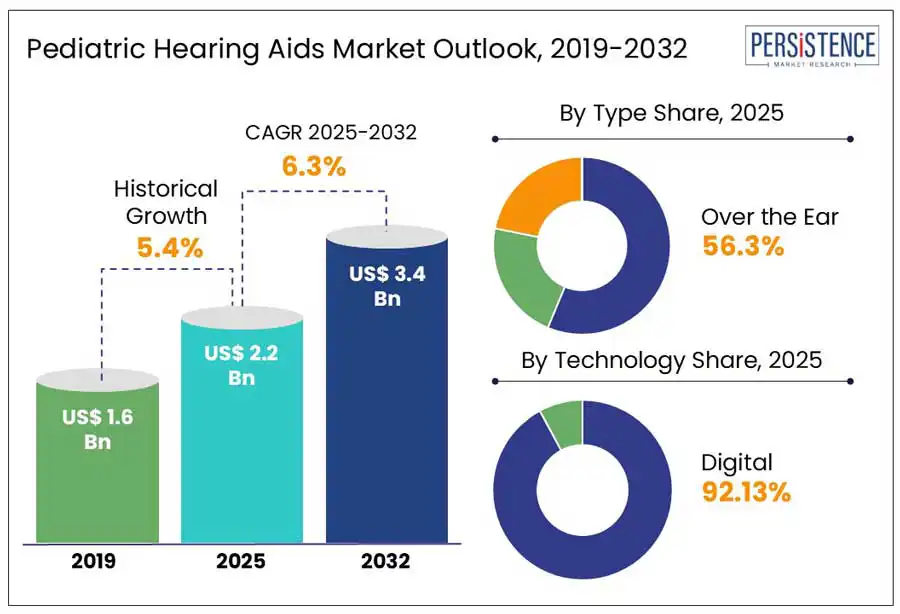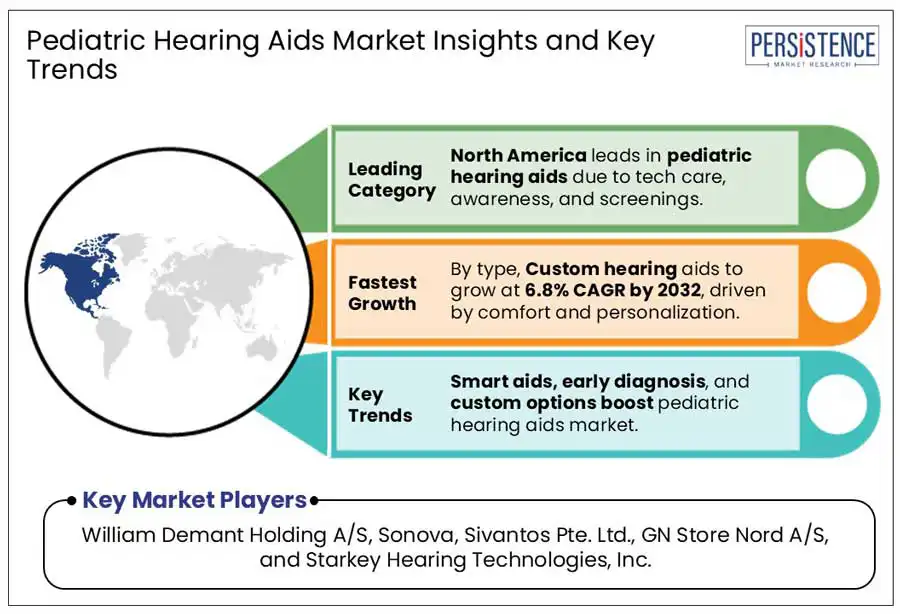Comprehensive Snapshot for Pediatric Hearing Aids Market Including Regional and Country Analysis in Brief.
Industry: Healthcare
Published Date: April-2025
Format: PPT*, PDF, EXCEL
Delivery Timelines: Contact Sales
Number of Pages: 170
Report ID: PMRREP4734
The global pediatric hearing aids market is anticipated to reach a value of US$2.2 billion in 2025 and likely attain a value of US$3.4 billion to witness a CAGR of 6.3% by 2032. According to Persistence Market Research, the pediatric hearing aids market witnessed significant growth, driven by greater awareness about the early detection of hearing issues in children and better access to specialized audiology services.
In 2024, the World Health Organization reported that globally more than 34 million children were affected by disabling hearing loss, emphasizing the critical need for hearing solutions tailored for young users. Pediatric hearing aids are uniquely crafted to suit children's needs, featuring compact designs, soft and safe materials, and advanced technologies such as Bluetooth connectivity, background noise reduction, and enhanced speech clarity to support their communication and developmental progress.

Key Industry Highlights:
|
Global Market Attribute |
Key Insights |
|
Pediatric Hearing Aids Market Size (2025E) |
US$ 2.2 Bn |
|
Market Value Forecast (2032F) |
US$ 3.4 Bn |
|
Projected Growth (CAGR 2025 to 2032) |
6.3% |
|
Historical Market Growth (CAGR 2019 to 2024) |
5.4% |
?A major factor driving the pediatric hearing aids market is the increasing incidence of hearing loss among children. Congenital hearing impairment affects a significant number of newborns globally, with estimates indicating that around two in every 1,000 babies are born with detectable levels of hearing loss in one or both ears.
Childhood hearing loss gets developed with time however it remains unnoticed in the former years of their life. Common conditions aggravating childhood hearing loss include infections, side effects from certain medications, chronic ear conditions or extended exposure to loud noises. The growing burden of auditory impairment creates a pressing need for early diagnosis and appropriate intervention. Without timely support, children with hearing loss are at the risk of delays in speech, language development, and social skills. Pediatric hearing aids serve as a vital tool in mitigating these challenges by providing consistent auditory input during critical developmental stages.
One of the significant restraints in the pediatric hearing aids market is the challenge of consistent device usage among young children. Ensuring that infants and toddlers wear hearing aids regularly is often difficult for both parents and audiologists. Factors such as the child’s age, level of hearing loss, and behavioral tendencies play a major role in adherence. Younger children, in particular are more prone to removing the devices, either out of discomfort or during moments of frustration and tantrums. As motor skills develop, many children begin to dislodge hearing aids manually reducing the dependency on hearing devices.
Additionally, parents frequently report issues such as poor device retention, discomfort, and fear of device loss or damage. These concerns hinder long-term compliance and negatively affect speech and language development. Families with lower educational backgrounds may also lack the awareness or resources to reinforce consistent use, thereby limiting the effectiveness and market growth of pediatric hearing aids.
Government and non-profit initiatives represent significant growth opportunities. Many countries have implemented mandatory newborn hearing screening programs helping to identify hearing impairments at an early stage. According to the Centers for Disease Control and Prevention (CDC), over 98% of newborns in the United States are screened for hearing loss. Programs such as the Early Hearing Detection and Intervention (EHDI) help ensure timely diagnosis and intervention thereby increasing the demand for pediatric hearing aids.
Additionally, global organizations such as the World Health Organization (WHO) advocate for accessible hearing care. In its 2021, World Report on Hearing, WHO emphasized that over 60% of hearing loss in children could be prevented with early detection and management. Non-profit groups also support underserved communities by offering low-cost or donated hearing aids and audiology services. These combined efforts improve awareness, access, and affordability, significantly boosting market potential worldwide.
Over-the-ear (OTE) hearing aids represent the most widely used type in the global market. These devices are preferred due to their durability, ease of handling, and suitability for a wide range of hearing loss levels. OTE models provide better amplification and accommodate various advanced features such as wireless connectivity, directional microphones, and telecoil systems.
Their larger size also allows for stronger batteries, making them ideal for children who require consistent usage throughout the day. Additionally, OTE devices are easier for audiologists and parents to adjust and maintain, contributing to their dominant market position.
Digital hearing aids significantly outperform analog models in the pediatric hearing aids market, accounting for nearly 92% share. This leading position is attributed to their enhanced audio processing capabilities, which offer better sound clarity and background noise reduction. For children, these features are crucial as they directly impact their ability to understand speech and develop language skills effectively. Unlike analog devices, digital hearing aids can be precisely adjusted to match a child’s unique hearing needs, offering a more personalized and effective solution.
Furthermore, digital models often include wireless connectivity and integration with mobile apps, which enhances usability for both parents and audiologists. As early hearing detection and intervention programs become more widespread and audiology practices adopt newer technologies, the demand for digital hearing aids continues to rise in pediatric care, reinforcing their presence in the market.

?Owing to the high penetration of leading market players, mostly in the U.S., North America emerged as a mature market in terms of pediatric hearing aids. Medicare and Medicaid Services have a proposed reimbursement scenario for hearing loss, which will upsurge the demand for hearing aid usage in North America in the coming years. The U.S. holds a major share among all countries in North America due to the growing awareness about pediatric hearing aids as well as favorable reimbursement policies.
The Gross Domestic Product (GDP) of a country significantly contributes to the health care expenditure. The GDP of various countries is gradually increasing every year. As a result, healthcare allocations have increased, which in turn is driving the growth of the global hearing aids market.
?Rise in research and development of novel and advanced products is likely to bode well during the forecast period. At present, Germany dominates the pediatric hearing aids market, followed by the U.K. owing to the high adoption rate of technologically advanced pediatric hearing aids. The leading manufacturers are focusing on technological advancements to strengthen their product offerings and boost their position. Leading market players in Europe for pediatric hearing aids are introducing innovative and expanded product lines to retain their market share.
Companies are increasing their research and development expenditure in order to develop innovative products. These novel products offer additional advantages than conventional hearing aids. Digital hearing aids enable connectivity to television, mobile phone, iPod and other electronic devices. Moreover, hearing impaired patients are inclined towards innovative features; hence, research and development drives the overall growth in the long-term. However, limited reimbursement policies available for patients with impaired hearing in the region by several governments might act as a roadblock in the growth of the market in Europe in the coming years.?
Asia Pacific is emerging as the fast-growing market for pediatric hearing aids. This growth is fueled by increasing awareness of early hearing loss detection, expanding healthcare infrastructure, and rising government initiatives focused on child health. A growing middle-class population, along with improved access to audiology services has contributed to higher adoption rates of hearing aids among children.
Additionally, countries such as China, India, and Japan are leading due to dense pediatric population and improved screening programs. Furthermore, the demand for technologically advanced yet affordable hearing devices continues to rise across urban and semi-urban areas. This strong market momentum reflects the region’s increasing focus on early intervention and accessibility to pediatric healthcare.
The global pediatric hearing aids market is competitive marked by the presence of several prominent global players. Key players dominate due to their innovative and child-specific product offerings. These players invest heavily in research and development to introduce advanced technologies such as Bluetooth connectivity, AI integration, and rechargeable batteries. Strategic collaborations, product launches, and geographic expansion are key growth strategies. Additionally, emerging players are gaining traction by offering affordable solutions tailored for developing regions. The competition is intense with companies focusing on user comfort, speech clarity, and design, suited for children.
|
Report Attribute |
Details |
|
Historical Data/Actuals |
2019 - 2024 |
|
Forecast Period |
2025 - 2032 |
|
Market Analysis Units |
Value: US$ Bn, Volume: As applicable |
|
Geographical Coverage |
|
|
Segmental Coverage |
|
|
Competitive Analysis |
|
|
Report Highlights |
|
|
Customization and Pricing |
Available upon request |
By Type
By Technology
By Age Group
By Type of Hearing Loss
By Sales Channel
By Region
To know more about delivery timeline for this report Contact Sales

The global market is estimated to increase from US$ 2.2 billion in 2025 to US$ 3.4 billion in 2032.
Rising childhood hearing loss cases, early diagnosis awareness, technological advancements, and improved access to pediatric audiology services drive market growth.
The market is projected to record a CAGR of 6.3% during the forecast period from 2025 to 2032.
Rising early screening programs, technological advancements, and expanding access in emerging markets offer strong growth opportunities.
William Demant Holding A/S, Sonova, Sivantos Pte. Ltd., GN Store Nord A/S, Starkey Hearing Technologies, Inc., and Others.